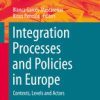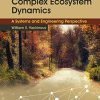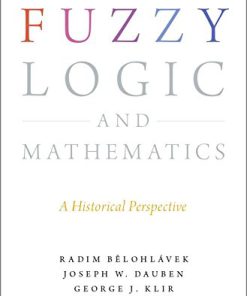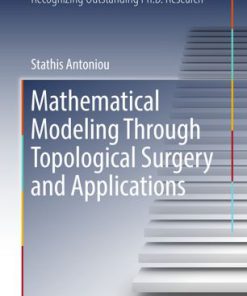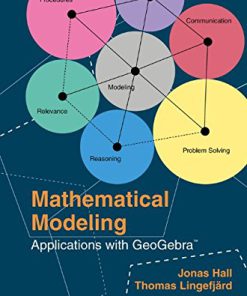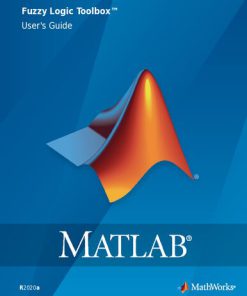Mathematical Modeling using Fuzzy Logic 1st Edition by Abhijit Pandit ISBN 0429751710 9780429751714
$50.00 Original price was: $50.00.$25.00Current price is: $25.00.
Mathematical Modeling using Fuzzy Logic 1st Edition by Abhijit Pandit – Ebook PDF Instant Download/Delivery: 0429751710, 978-0429751714
Full dowload Mathematical Modeling using Fuzzy Logic 1st Edition after payment

Product details:
ISBN 10: 0429751710
ISBN 13: 978-0429751714
Author: Abhijit Pandit
Mathematical Modeling using Fuzzy Logic has been a dream project for the author. Fuzzy logic provides a unique method of approximate reasoning in an imperfect world. This text is a bridge to the principles of fuzzy logic through an application-focused approach to selected topics in engineering and management. The many examples point to the richer solutions obtained through fuzzy logic and to the possibilities of much wider applications. There are relatively very few texts available at present in fuzzy logic applications. The style and content of this text is complementary to those already available. New areas of application, like application of fuzzy logic in modeling of sustainability, are presented in a graded approach in which the underlying concepts are first described. The text is broadly divided into two parts: the first treats processes, materials, and system applications related to fuzzy logic, and the second delves into the modeling of sustainability with the help of fuzzy logic.
This book offers comprehensive coverage of the most essential topics, including:
Treating processes, materials, system applications related to fuzzy logic
Highlighting new areas of application of fuzzy logic
Identifying possibilities of much wider applications of fuzzy logic
Modeling of sustainability with the help of fuzzy logic
The level enables a selection of the text to be made for the substance of undergraduate-, graduate-, and postgraduate-level courses. There is also sufficient volume and quality for the basis of a postgraduate course. A more restricted and judicious selection can provide the material for a professional short course and various university-level courses.
Mathematical Modeling using Fuzzy Logic 1st Table of contents:
1. Introduction
- 1.1 Rule-Based Fuzzy Logic Systems
- 1.2 A New Direction for FLSs
- 1.3 New Concepts and Their Historical Background
- 1.4 Fundamental Diamond Requirement
- 1.5 The Flow of Uncertainties
- 1.6 Existing Literature on Type 2 Fuzzy Sets
- 1.7 Coverage
- 1.8 Applicability Outside of Rule-Based FLS
- 1.9 Computation
- 1.10 Primer on Fuzzy Sets
- 1.10.1 Fuzzy Sets
- 1.10.2 From Fuzzy Sets to Crisp Sets
- 1.10.3 Linguistic Variables
- 1.10.4 Membership Functions
- 1.10.5 Some Terminology
- 1.10.6 Set-Theoretic Operations on Crisp Sets
- 1.10.7 Set-Theoretic Operations for Fuzzy Sets
- 1.10.8 Crisp Relations and Compositions on the Same Product Space
- 1.10.9 Relations and Compositions
- 1.10.10 Hedges
- 1.10.11 Expansion Principle
- 1.11 FL Primer
- 1.11.1 Crisp Logic
- 1.11.2 From Crisp Logic to FL
- 1.12 Remarks
- 1.13 Exercise
- References
2. Sources of Uncertainty
- 2.1 Uncertainty
- 2.1.1 Uncertainty: General Discussion
- 2.1.2 Uncertainty at FLS
- 2.2 Words Mean Different Things to Different People
- 2.3 Exercise
- References
3. Membership Functions and Uncertainty
- 3.1 Introduction
- 3.2 Type 1 Membership Function
- 3.2.1 The Concept of a Type 2 Fuzzy Set
- 3.2.2 Definition of Type 2 Fuzzy Sets and Related Concepts
- 3.2.3 Type 2 Fuzzy Sets and Examples of FOU
- 3.2.4 Upper and Lower Membership Functions
- 3.2.5 A Type 1 Purge Set Represented by a Type 2 Fuzzy Set
- 3.2.6 0 and 1 Membership of Type 2 Fuzzy Set
- 3.3 Back to the Language Label
- 3.4 Exercise
- References
4. Case Studies
- 4.1 Introduction
- 4.2 Time Series Prediction
- 4.2.1 Extracting Rules from Data
- 4.2.2 Classic Time Series Forecasting Methods
- 4.2.2.1 Autoregression (AR)
- 4.2.2.2 Moving Average (MA)
- 4.2.2.3 Autoregressive Moving Average Type (ARMA)
- 4.2.2.4 Autoregressive Integrated Moving Average (ARIMA)
- 4.2.2.5 Seasonal Autoregressive Integrated Moving Average (SARIMA)
- 4.2.2.6 Seasonal Autoregressive Integrated Moving Average (SARIMAX) Using Exogenous Regression Variables
- 4.2.2.7 Vector Autoregression (VAR)
- 4.2.2.8 Vector Autoregressive Moving Average (VARMA)
- 4.2.2.9 Vector Autoregression Moving-Average with Exogenous Regressors (VARMAX)
- 4.2.2.10 Simple Exponential Smoothing (SES)
- 4.2.2.11 Holt–Winters Exponential Smoothing (HWES)
- 4.3 Knowledge Mining Using Surveys
- 4.3.1 Knowledge Mining Methodology
- 4.4 Exercise
- References
5. Singleton Type 1 Fuzzy Logic Systems: No Uncertainties
- 5.1 Introduction
- 5.2 Rules
- 5.3 Fuzzy Inference Engine
- 5.4 Fuzzification and Its Effect on Reasoning
- 5.4.1 Fuzzifier
- 5.5 Defuzzification
- 5.5.1 Centroid Defuzzifier
- 5.5.2 Bisecting Defuzzifier
- 5.5.3 Weighted Average Defuzzifier
- 5.5.4 Midpoint of Maximum Defuzzifier
- 5.5.5 Largest of Maximum Defuzzifier
- 5.5.6 Smallest Maximum Defuzzifier
- 5.6 FLS Design
- 5.6.1 Back-Propagation (the Steepest Descent) Method
- 5.6.2 SVD-QR Method
- 5.6.3 Repetitive Diamond Method
- 5.7 Sample Study: Time Series Prediction
- 5.8 Case Study: Data Mining
- 5.9 Exercise
- References
6. Centroid of a Type 2 Fuzzy Set: Type Reduction
- 6.1 Introduction
- 6.2 Unspecified Consequences for the Center
- 6.3 Generalization Center for Interval Type 2 Fuzzy Set
- 6.4 Interval Type 2 Center of Fuzzy Set
- 6.5 Type Reduction: Unspecified Consequences
- 6.5.1 Center Type Reduction
- 6.5.2 Height Type Reduction
- 6.5.3 Set Center Type Reduction
- 6.5.4 Computational Complexity of Type Reduction
- 6.5.5 Conclusion
- 6.6 Exercise
- References
7. Modeling of Sustainability
- 7.1 The Meaning of Sustainability
- 7.2 Introduction to Sustainability by Fuzzy Assessment (SAFE) Model
- 7.3 SAFE Model Overview
- 7.4 Key Indicators of Sustainable Development
- 7.5 Measuring Sustainability
- 7.6 Fuzzy Assessment
- 7.7 Sensitivity Analysis
- 7.8 Advantages and Disadvantages of the SAFE Model
- 7.9 Sample Study for the SAFE Model
- 7.9.1 SAFE for Energy Sustainability
- 7.10 Conclusion
- 7.11 Exercise
- References
8. Epilogue
- 8.1 Introduction
- 8.2 Type 2 vs. Type 1 FLS
- 8.3 Application for Type 2 FLS
- 8.4 Rule-Based Nomenclature for Video Traffic
- 8.4.1 Selected Function
- 8.4.2 FOU on Function
- 8.4.3 Rules
- 8.4.4 FOU for Measurement
- 8.4.5 FL RBC’s Parameters
- 8.4.6 Calculation Formula for Type 1 FL RBC
- 8.4.7 Calculation Formula for Type 2 FL RBC
- 8.4.8 Optimization of Rule Design Parameters
- 8.4.9 FL RBC Test
- 8.4.10 Results and Conclusions
- 8.5 Equalization of Time-Varying Nonlinear Digital Contacts
- 8.5.1 Preparation for Equalization of Water Supply
- 8.5.2 Why Type 2 FAFs Are Needed?
- 8.5.3 FAF Design
- 8.5.4 Simulation and Conclusion
- 8.6 Liaison System with ISI and CCI
- 8.7 Connection Ticket Rental for ATM Networks
- 8.7.1 Survey-Based CAC Using Type 2 FLS: Overview
- 8.7.2 Extraction of Knowledge for CAC
- 8.7.3 Survey Process
- 8.7.4 CAC Visualization Boundaries and Results
- 8.8 Exercise
People also search for Mathematical Modeling using Fuzzy Logic 1st :
mathematical modeling using functions examples
mathematical modeling and computation in finance pdf
a mathematical model of the finding of usability problems
fuzzy logic mathematical model
fuzzy logic machine learning python
Tags:
Abhijit Pandit,Mathematical,Modeling,Fuzzy Logic 1st
You may also like…
Uncategorized
Computers - Applications & Software
Mathematics
Introduction to Mathematical Modeling 1st Edition by Mayer Humi ISBN 9781498728003 978-1498728003


